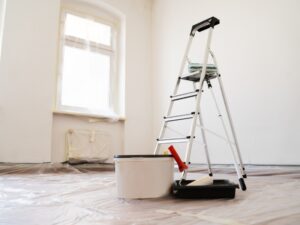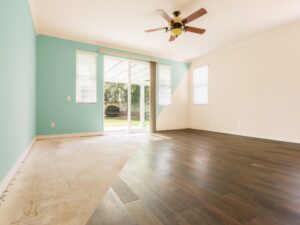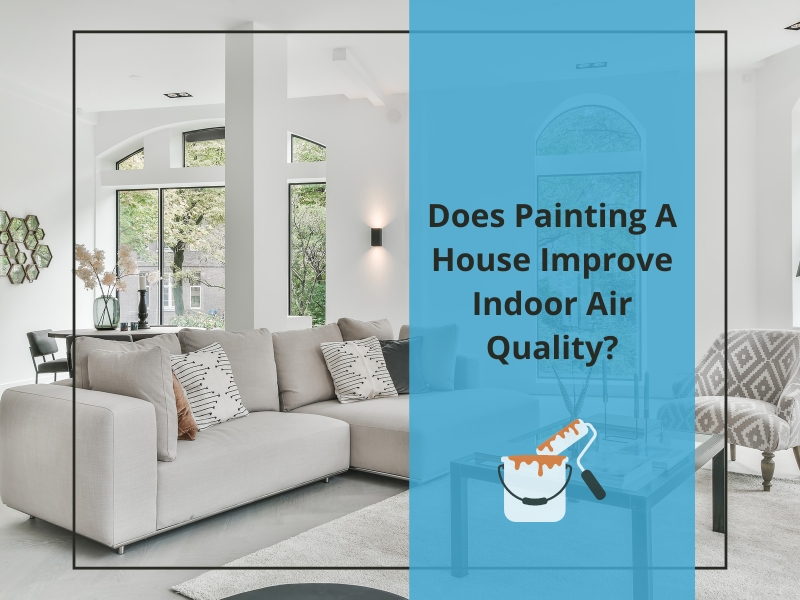Indoor air quality plays a crucial role in maintaining a healthy home. Painting your house, whether it’s a fresh coat or a complete renovation, can impact the air quality within your home. This guide will explore how painting affects indoor air quality, the role of paint fumes and VOCs, and the benefits of professional painting services.
How can painting a house affect indoor air quality?
Painting your house involves more than just picking out a new colour scheme. The process can notably impact indoor air quality in several ways. Here’s a closer look at how painting can affect your home environment:
- Dust and debris: During painting, especially in older homes or those undergoing extensive prep work, dust and debris can become airborne. This dust can settle on surfaces or be inhaled, potentially affecting respiratory health. Proper preparation, such as covering furniture and flooring and thoroughly cleaning after painting, can help minimise the amount of dust and debris in the air.
- Paint application: The method used to apply paint—whether brushing, rolling, or spraying—can influence the amount of airborne particles. Spraying, for example, can create more airborne paint mist compared to brushing or moving, which may result in higher concentrations of particles in the air. Ensuring that paint is applied carefully and evenly can help reduce the number of particles released into the indoor environment.
- Ventilation: Adequate ventilation during and after the painting process is crucial for maintaining good indoor air quality. Proper ventilation helps dissipate any airborne particles and fumes the paint releases. Opening windows, using fans, and employing air purifiers can enhance airflow and speed up the removal of these particles from your home, making the air cleaner and healthier.
Can paint fumes harm indoor air quality?
Paint fumes are often a concern for homeowners looking to improve their indoor environment. Here’s how paint fumes can affect indoor air quality:
- Short-term effects: Exposure to paint fumes can cause headaches, dizziness, and respiratory issues. These effects are typically short-lived but can be unpleasant and may temporarily disrupt daily activities. Ensuring proper ventilation can help alleviate these symptoms more quickly.
- Long-term exposure: Prolonged exposure to high paint fumes can lead to more severe health problems. Chronic exposure may contribute to respiratory issues, asthma, or other long-term health conditions. This is why avoiding low-VOC paints and maintaining good ventilation is crucial to minimise these risks.
- Immediate mitigation: Ventilating the space well during and after painting can help reduce the concentration of harmful fumes in the air. In addition to ventilation, using air purifiers with activated carbon filters can further assist in removing residual fumes from the indoor environment.
Should you worry about VOCs during your painting project?
Volatile Organic Compounds (VOCs) are chemicals in many traditional paints that can negatively affect indoor air quality. Here’s what you need to know about VOCs:
- Health risks: VOCs can contribute to respiratory problems, headaches, and other health issues. They evaporate into the air as the paint dries.
- Low-VOC alternatives: Choosing paints with low or no VOCs can significantly reduce the impact on indoor air quality. These paints are less harmful and more environmentally friendly.
- Regulations and standards: In Sydney, some regulations limit the amount of VOCs in paints. Opting for paints that comply with these standards ensures better indoor air quality.
How often should you repaint to maintain good indoor air quality?
Regular maintenance is vital to preserving indoor air quality. Here’s a guideline on how often to repaint:
- Every 5-7 years: Repainting every 5-7 years can help maintain good indoor air quality in most homes. This timeframe can vary based on the paint’s durability and the room’s use.
- High-traffic areas: Rooms that experience high traffic or moisture, such as kitchens and bathrooms, may need more frequent touch-ups or repainting.
- Inspection and touch-ups: Regularly inspect your walls for signs of wear or damage, and perform touch-ups to prevent further deterioration.

What are the benefits of professional house painting for air quality?
Opting for professional house painting offers several advantages when it comes to indoor air quality:
- Expertise in paint selection: Professionals can recommend high-quality, low-VOC paints that are better for indoor air quality.
- Proper preparation: Experienced painters ensure that surfaces are properly prepped, reducing the likelihood of dust and debris affecting the air.
- Efficient ventilation: Professionals understand the importance of ventilation and can implement strategies to minimise the impact of paint fumes.
- Attention to detail: Professional painters adhere to high standards, ensuring that your home’s painting job is done correctly and safely, improving indoor air quality.

What steps should you take before and after painting a house?
To ensure that your painting project does not negatively affect indoor air quality, follow these steps:
- Before painting:
- Choose low-VOC paint: Select paints with low or no VOCs to minimise the impact on air quality.
- Ventilate the area: Open windows and use fans to improve airflow.
- Prepare the space: Cover furniture and floors to prevent dust and debris from spreading.
- During painting:
- Ensure proper ventilation: Keep windows open and use fans to circulate air.
- Avoid excessive application: Apply paint in thin layers to reduce the amount of fumes released.
- After painting:
- Continue ventilation: Keep the area well-ventilated for several days after painting to allow fumes to dissipate.
- Check for residual odours: Ensure that any lingering paint odours are addressed by ventilating the space.
Enhance your home’s indoor air quality with Sydney Paintmasters!
Suppose you’re considering painting your home to ensure the best indoor air quality. In that case, Sydney Paintmasters is here to help. Our team of professionals is dedicated to delivering high-quality painting services in Sydney that enhance the aesthetics of your property and contribute to a healthier indoor environment. We offer various services, including interior and exterior painting and expert advice on choosing suitable paints for your needs.
Contact Sydney Paintmasters today for a consultation and experience the benefits of professional painting services prioritising beauty and air quality. Let us help you create a healthier, more beautiful home.

